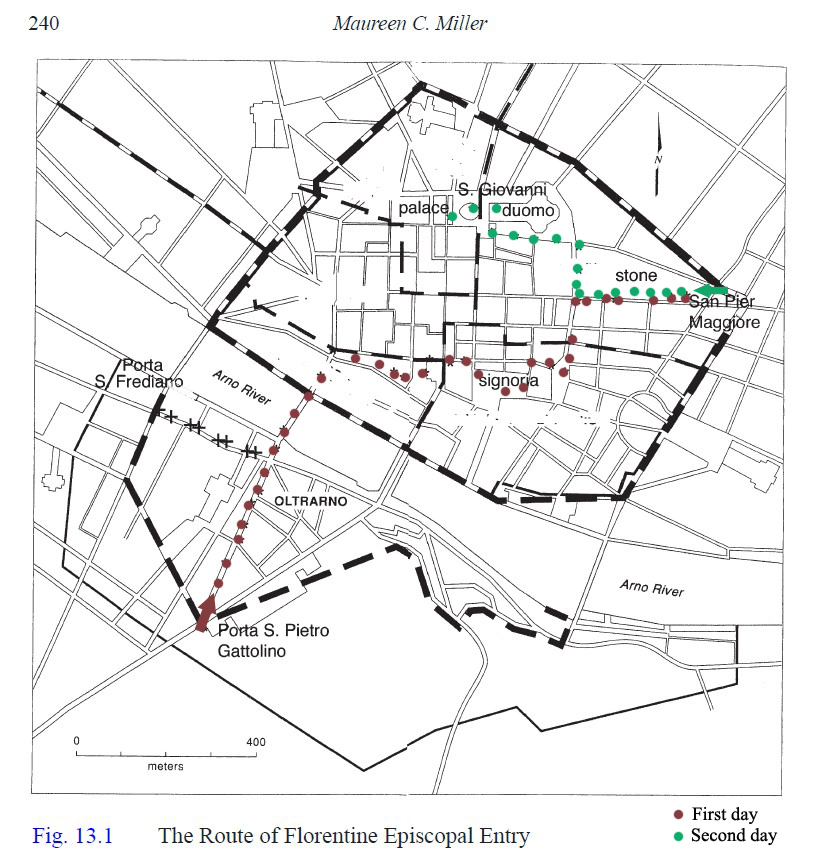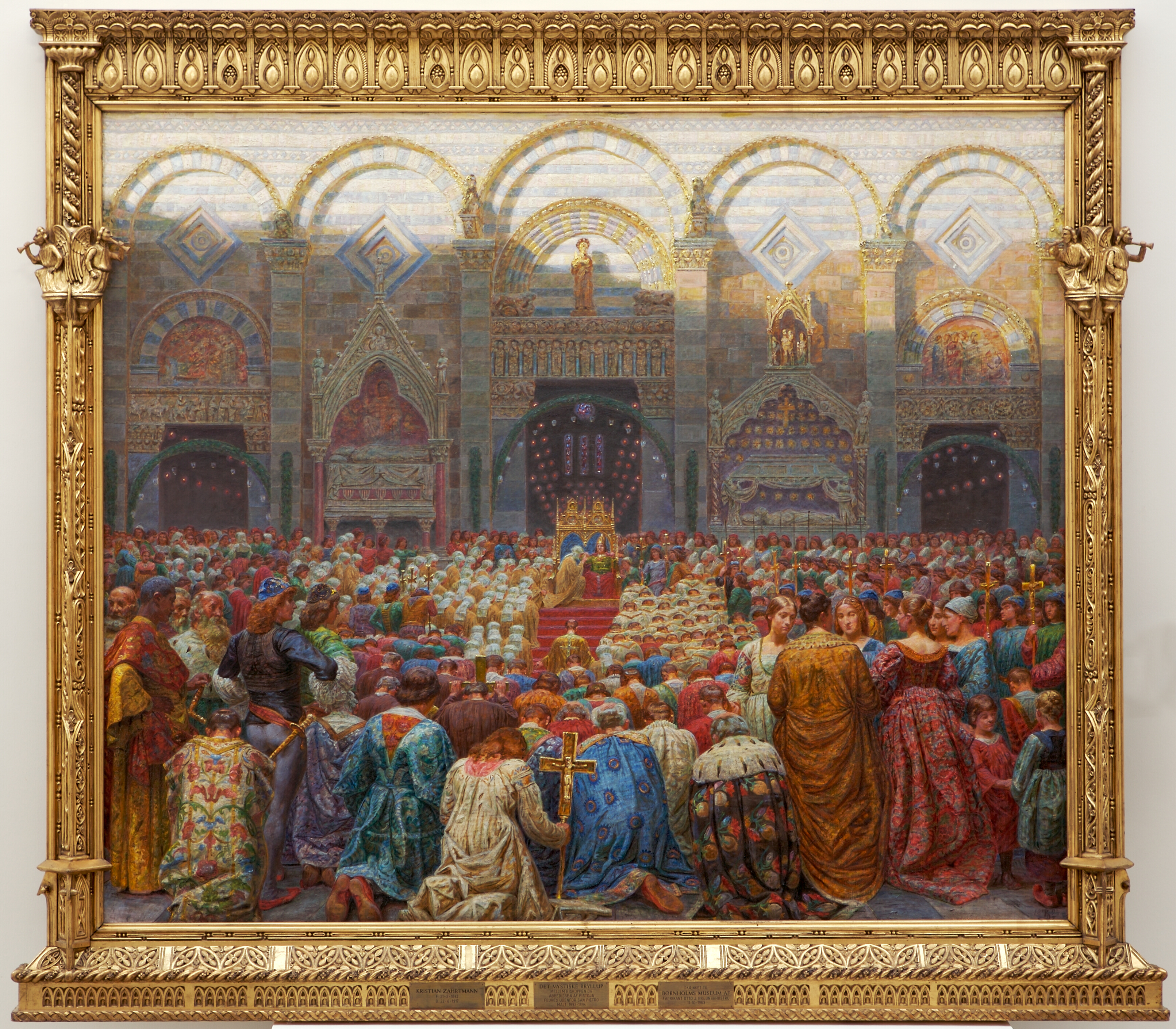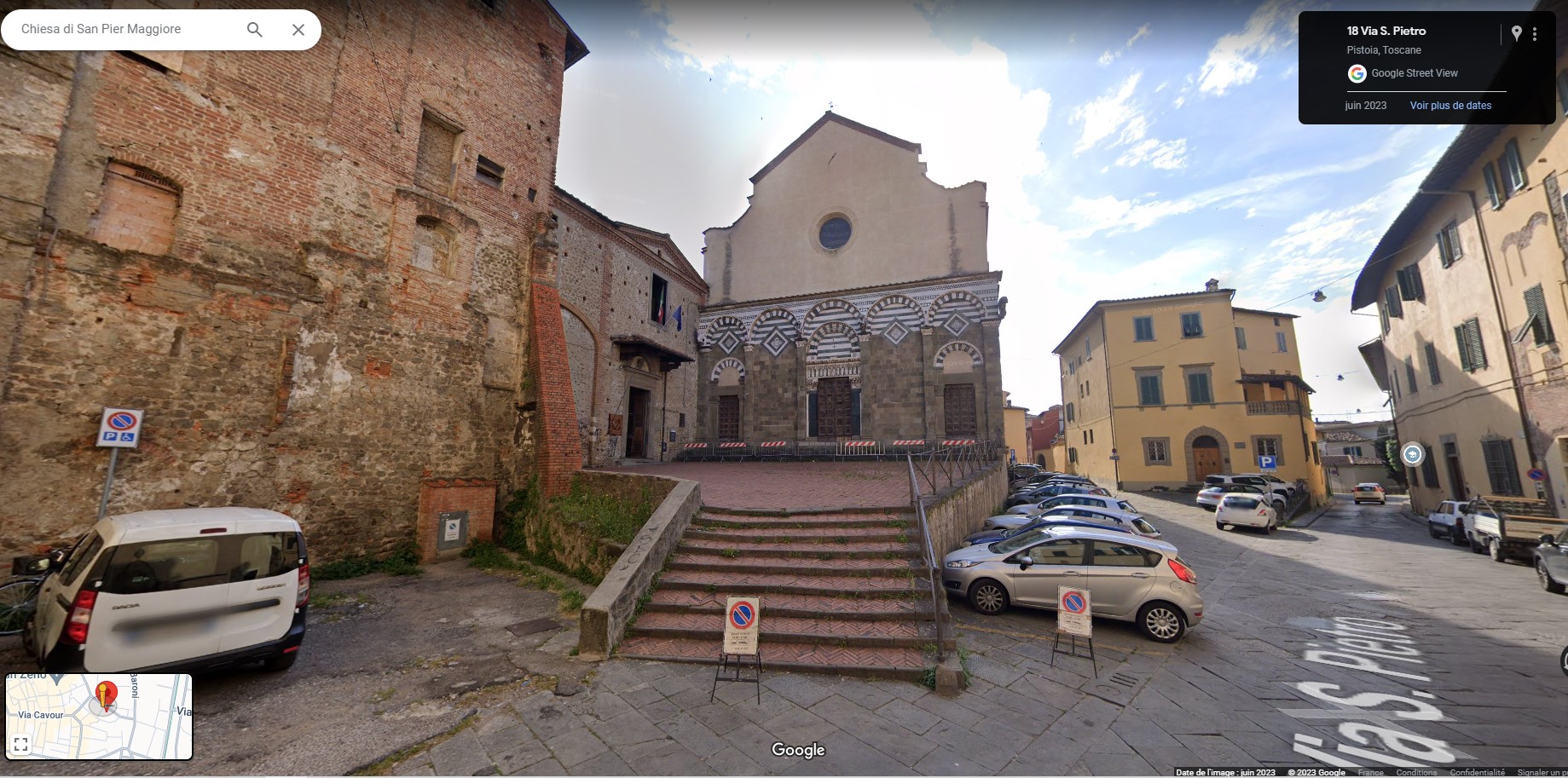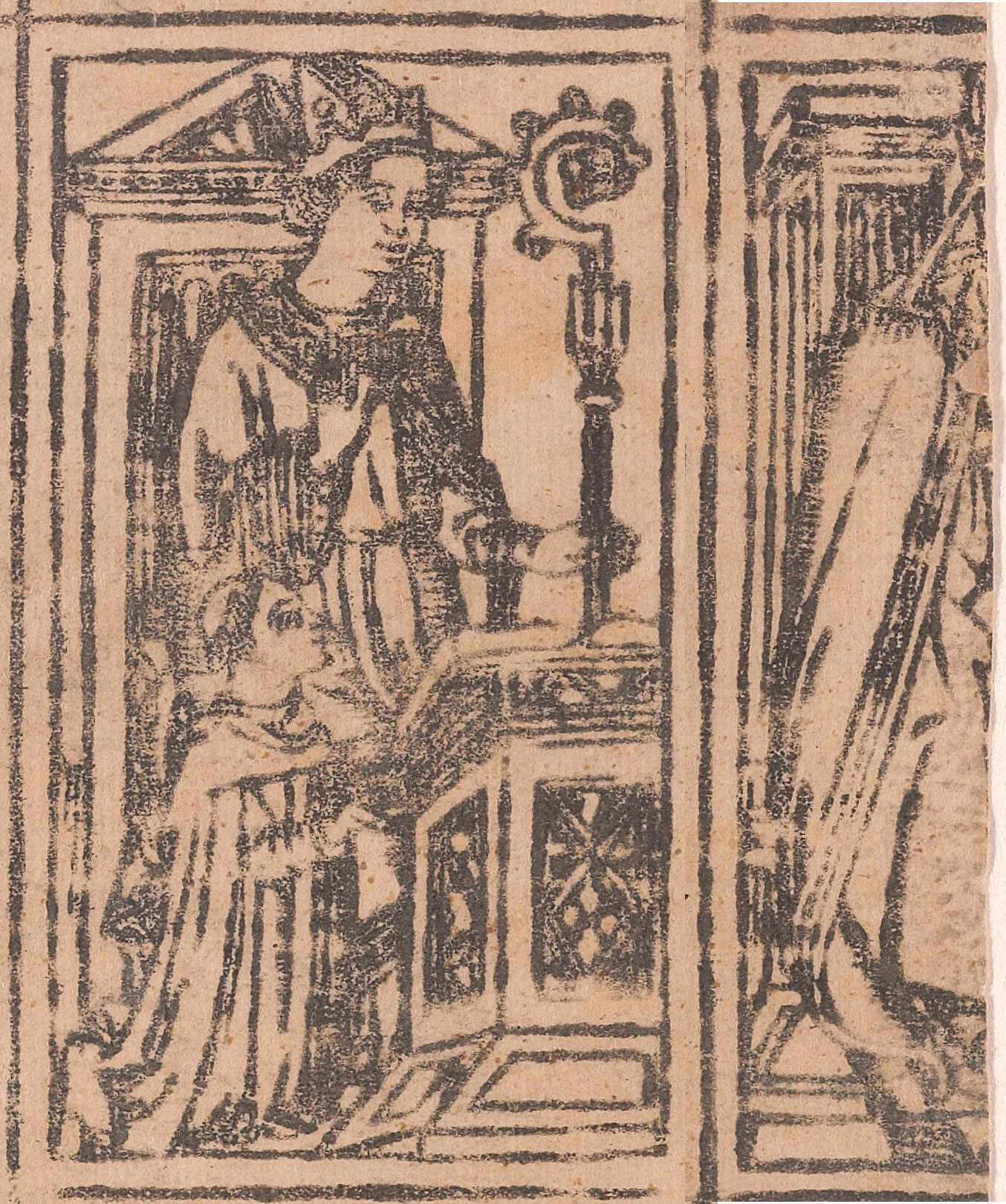The subject has been rigorously studied only in the last 20 years, particularly by Maureen Miller and Sharon Strocchia (see below for references).
I have put these thoughts in the Unicorn Terrace because it is "playful historical pondering." The most playful of my ponderings is to wonder if the Abbess might have had the nickname "la papessa" sometimes. One analogy for "popular consecration" like this is the nickname "Eight Saints" for the eight officials charged to organize Florence's defense against Gregory XI in 1376.
Here are some quotes from the first full study, in 2006, followed by a list of the Abbesses of San Pier Maggiore and the Bishops of Florence for the 14th and 15th centuries. The full ritual with the ring and bed was done until 1446, when Bishop Antonino Pierozzi (1446-1459) dispensed with staying overnight on the bed made for him, although he married the Abbess Maddalena del Portico (who was by then around 80 years old) by placing the ring on her finger. Pierozzi's successor Orlando Bonarli (in office 1459-1461) apparently observed "no rite at all," although his three successors between 1461 to 1508 restored it. Nevertheless, the convent's power had been weakened by Antonino's example.
Interesting for us is that it was done three times in the 1430s - April and August of 1437, and December of 1439 - after having been done last in 1411 (the long tenure of Antonino Amerigo Corsini, 1411-1435). So the ritual was fresh in the minds of the people just at the time we think the game of Triumphs to have been invented.

Adadpted from Maureen Miller, "Urban Space, Sacred Topography, and Ritual Meanings in Florence: The Route fo the Bishop's Entry, c. 1200-1600,” in John S. Ott and Anna Trumbore Jones, eds. The Bishop Reformed: Studies of Episcopal Power and Culture in the Central Middle Ages; Routledge, 2016; pp. 237-249, here p. 240.
Maureen Miller, “Why the Bishop of Florence Had to Get Married,” Speculum, Vol. 81, No. 4 (October, 2006), pp. 1055-1091.
https://www.jstor.org/stable/20463931?s ... b_contents
1302 isMany who have studied the history of medieval and Renaissance Florence have noted the elaborate ritual through which a new bishop of the city took possession of his see. Documented from 1286 to 1584, the rite's most striking feature was a ritual marriage between the bishop and a local abbess. While scholars have offered motives and meanings for various elements in the adventus, the marriage ritual tends to be mentioned rather than explained. Why did the bishop marry an abbess as he entered his new domain?
Sixteenth-century Florentines explained the custom by asserting that the abbess represented the Florentine see or people [Miller's note: “I reference here a 1508 description of the entry of Cosimo de' Pazzi, during which the Abbess Andrea de' Buondelmonti received a ring from the bishop 'nomine Ecclesie Florentine' (in the name of Florentine Church).” This symbolic meaning is not articulated earlier in the sources, although historians in attempting to understand the peculiar ritual have used it in discussing the thirteenth- and fourteenth-century evidence (two of them cited).]
Only the Florentine rite and two others attributed to Florentine influence are presently known [Pistoia and Troyes, France].
“The rarity of the ritual suggests that the reasons for the creation and endurance of the Florentine episcopal marriage were local. … The marriage of the bishop of Florence to the abbess of San Pier Maggiore may be exceptional, but the conditions it addressed were not. Close analysis of this marriage ritual within the larger episcopal entry also reveals that the marriage was not a periphal part of the Florentine rite. It was central, informing the entire structure of the ritual.”
In 1894, the Danish artist Kristian Zahrtmann painted "Det mystiske bryllup mellem biskoppen og abbedissen af Pistoja fejres udenfor San Pietro (The mystical marriage between the bishop and the abbess of Pistoia celebrated outside San Pietro)," a romantic version of Pistoia's version, showing the Abbess kissing the newly-installed Bishop's hand:“the first direct evidence we have of a rather odd feature of the Florentine ritual of episcopal adventus: during it the bishop had to “marry” the abbess of San Pier Maggiore [The 1286 document mentions only the “pulcherimum lectum (most beautiful bed)” that the abbess had prepared for the bishop and the fact that he spent the night at the convent]. We do not get a clear description of the rite until a memoriale of 1370 written by Simone della Tosa, a work that detailed all the rights of the Visdomini lineage concerning the see. In the section on the adventus ritual, Simone recounted that after the meal at the convent the bishop “goes into the chapter room where the abbess and all her sister are gathered. In the presence of many gathered there, giving a little sermon, he marries the abbess (isposa la Badessa) and gives her a beautiful ring.”
(ASF (Archivio di Stato di Firenze), Manoscritti, 167, insert 2, fol. 46v, dated 1370: “... quando il Vescovo e tutti anno mangiato se ne va 'in Capitolo, e la truova la Badessa del detto Monisterio con tute le sue suore; & in presenza di molti, che sono presenti, dicendo alcuno piccolo Sermone isposa la Badessa, e dalle un bello Anello di Oro...”
Full quote: “When the bishop and everyone had eaten, they went into the chapter room, where they found the abbess of that convent and all the nuns. In the presence of the many people in attendance, the bishop gave a brief sermon and married the abbess, giving her a beautiful gold ring. He also donated the caparisoned horse he had ridden in procession. The abbess was obliged to donate a bed, in which the bishop was obliged to sleep that night.”

https://fr.m.wikipedia.org/wiki/Fichier ... roject.jpg
Zahrtmann certainly modelled it on the real church in Pistoia; only the density of the crowd on that scale seems exaggerated -

(screenshot of Google Street View taken in June 2023)
References to Strocchia: Sharon Strocchia, Nuns and Nunneries in Renaissance Florence, Johns Hopkins UP, 2009.
Abbesses of S. Pier Maggiore 14th - 15th century
Giustina di Puccio elected in 1319 (ASF Diplomatico, Lunghe, 23 November 1319)
Benedetta Macci 1350-1395
Antonia Bardi 29 December 1395- 4 August 1400 (Strocchia p. 9 and 201 note 28)
Lucia Falconieri 1400-1411
Maddalena del Portico of Lucca 1411-1460 (born c. 1365, vowed 1375)
Antonia Acciaiuoli 1460-1474
Benedetta Riccoldi 1474-1489
Gostanza Alessandri 1489-1507
(Strocchia p. 208 note 140)
Bishops of Florence 14th - 15th century
https://www.catholic-hierarchy.org/diocese/dfire.html
References to Strocchia: Sharon T. Strocchia, “When the Bishop Married the Abbess: Masculinity and Power in Florentine Episcopal Entry Rites, 1300-1600,” Gender & History, Vol. 19, No. 2, August 2007, pp. 346-368.
Francesco degli Atti 18 March 1355 – 23 December 1356
- Abbess Benedetta Macci
Filippo dell'Antella 27 February 1357- 20 April 1363
- Abbess Benedetta Macci
Pietro Corsini 1 September 1363-7 June 1370
- Abbess Benedetta Macci
Angelo Ricasoli 19 June 1370-9 February 1383
- Abbess Benedetta Macci
Angelo Acciaiuoli, 3 June 1383/(entry on) 6 January 1384-18 March 1385
- Abbess Benedetta Macci
Bartolomeo Oliari da Padova 9 December 1385 (entry 28 January 1386 Miller 1066)-18 December 1389
- Abbess Benedetta Macci
Onofrio Visdomini dello Stecchuto (entry 13 March per Miller 1066) 15 May 1390-13 December 1400
- Abbess Benedetta Macci
Alamanno Adimari 13 December 1400-16 November 1401 (undocumented; Strocchia 365 note 48)
- Abbess Lucia Falconieri
Jacopo Palladini 16 November 1401 (1405)-18 July 1410
- Abbess Lucia Falconieri
Francesco Zabarella 18 July 1410-17 June 1411 (undocumented; Strocchia 365 note 48)
- Abbess Lucia Falconieri
Sant'Antonino Amerigo Corsini 16 July 1411 (entry December 1411) to 16 March 1435 (made Archbishop 10 May 1419)
- Abbess Lucia Falconieri or Maddalena del Portico
Giovanni Vitelleschi 12/15 October 1435; entry on 25 April 1437 (reassigned 9 August 1437) (Miller 1066 note 41)
- Abbess Maddalena del Portico
Lodovico Trevisan / Scarampi Mezzarota 6 August 1437 to 18 December 1439
- Abbess Maddalena del Portico
Bartolomeo Zabarella 18 December 1439 to 21 December 1445
- Abbess Maddalena del Portico
Sant'Antonino Pierozzi 10 January / 13 March 1446 to 2 May 1459 (ring but no bed or stay, Stroc. 356)
- Abbess Maddalena del Portico
Orlando Bonarli 16 June / 15 July 1459 to 10 February 1461 (no rite at all, Strocchia 356)
- Abbess Maddalena del Portico
Giovanni Neroni / de' Diotisalvi 22 March 1461- 18 July 1473
- Abbess Antonia Acciaiuoli
Pietro Riario 20 July 1473 to 3 January 1474
- Abbess Antonia Acciaiuli or Benedetta Riccoldi
Rinaldo Orsini 28 January 1474 to 5 July (?) 1508
- Abbess Benedetta Riccoldi
Cosimo Pazzi June 1508 to (ring but no bed, Strocchia 357)
- Abbess Andrea Buondelmonti (Strocchia 357)

